Sleep Center

The Joint Commission Accredited Sleep Center in Pulaski offers solution to debilitating sleep disruptions. By combining technology in our sleep lab with a personal touch, our registered technologist will conduct a thorough evaluation of potential sleep disorders and generate a comprehensive diagnostic report. With this information, a treatment plan can be implemented.
Next Steps
Common Sleep Disorders
- Sleep Apnea
- Narcolepsy
- Chronic Insomnia
- Restless Leg Syndrome
- Sleep Walking
If you frequently feel fatigued, irritable, depressed, forgetful, moody, ill, unproductive or if you are making more errors or misjudgments call 931.363.7531 and ask for our Sleep Center.
What to Expect During a Sleep Study
In-Lab sleep study-Overview
An in-lab sleep study provides a board certified sleep medicine physician with the most complete evaluation of your sleep. You will be required to stay overnight at the Sleep Center.
An in-lab sleep study, also known as a polysomnogram, records your brain waves, heartbeat and breathing as you sleep. It also records your eye movements, limb movements and oxygen in your blood. This data will help your doctor make a diagnosis and develop a treatment plan.
An in-lab sleep study is the way to ensure that you have the proper diagnosis for a sleep disorder. Speak with your health care provider if you think you might need a sleep study.
Preparing for an In-Lab Sleep Study
An in-lab sleep study involves an overnight stay at the Sleep Center or hospital. These environments are set up to make you as comfortable as possible so you can have a full night’s sleep. Typically, you will not need to report for your sleep study until early evening.
On the day of your in-lab sleep study, you should:
- Try to follow your regular routine as much as possible
- Avoid napping
- Eliminate use of caffeine after lunch
- Shower and avoid using hair sprays, gels and lotion that could interfere with the sleep recording
- Bring your Sleep Study Package that you received in the mail. If you did not receive the package, one will be provided and filled out after arrival.
Arrival time for your sleep study is 730pm – 8pm, bring any items that you need for your nightly routine. Pack an overnight bag. Example of things you may bring:
- Comfortable pajamas or clothes to sleep in
- Makeup remover
- Reading material
- Your own Pillow
- Clean clothes for the morning.
You are provided with a shower if you wish to have one in the AM. So soap, shampoo and conditioner, etc. When you arrive, a sleep technologist will ask about your sleep habits. There will be a pre-sleep questionnaire for you to fill out.
You will have some time to make yourself at home. There will not be any other patients in your room. You will have a bathroom available to use, and you will have a television that you can watch.
Testing Process & Results
Testing Process
When you are ready to go to bed, the sleep technologist will attach sensors to your body. The sensors, which are taped to you, monitor your body while you sleep. These sensors are painless. Make sure to tell the technologist if you if you are allergic or sensitive to any adhesives.
The sensors measure your:
- Brain waves
- Chin muscle activity
- Heart rate
- Breathing
- Oxygen levels
- Leg movements
The wires are long enough to let you move around and turn over in bed. At the start of the test, you will be asked to move your eyes, clench your teeth and move your legs. This will make sure that the sensors are working.
You are free to read or watch TV until your normal bedtime. When it is time for you to try to go to sleep, the lights will go off and a low-light video camera will allow the technologist to see you from a nearby room. If a sensor comes loose or you need to go to the bathroom during the night, the technologist will have to help you with the wires.
Many patients do not sleep as well as they would at home. This may be because of the sensors or the unfamiliar environment. This typically does not affect the results. Nearly everyone falls asleep during an in-lab study. In most cases, you do not need a full eight hours of sleep for the doctor to make a diagnosis. In the morning the technologist will test and then remove the sensors. You may be asked to fill out a morning questionnaire that asks about the quality of your sleep and your experience in the Sleep Center. The in-lab study is complete once you are awake and the sensors have been removed.
